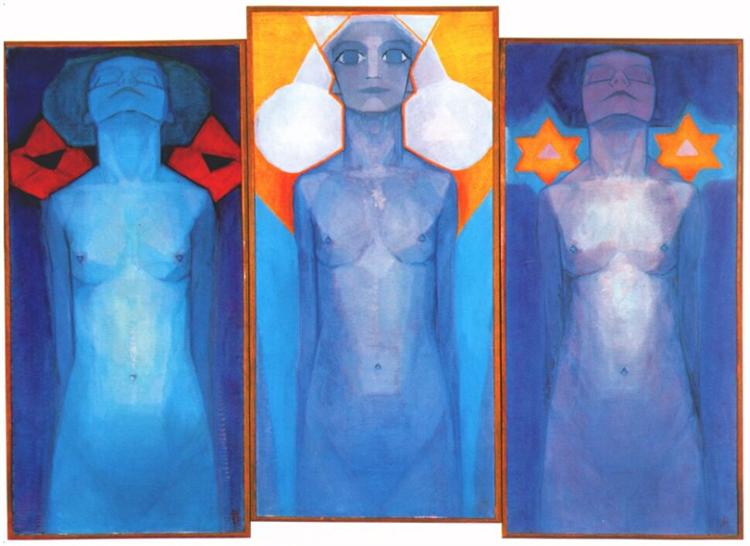THE BRAIN OF THE PLANET (5)
By:
September 13, 2023

Lilith Lorraine’s feminist utopian novelette The Brain of the Planet was published by David Lasser as a chapbook in Hugo Gernsback’s Science Fiction Series in 1929. HiLoBooks is pleased to serialize it here for HILOBROW’s readers.
ALL INSTALLMENTS: 1 | 2 | 3 | 4 | 5 | 6 | 7 | 8.
CHAPTER III
Confusion in the World
Three years later the strangers had installed their broadcasting station. Weary goatherds, guarding their flocks on the sparsely-vegetated slopes below them, were startled at first by a low, humming sound. Later they became accustomed to it. Some one told them that it was just two more crazy Americans fooling with Satan’s latest device, the radio. A polished metal monster might have been seen squatting on the edge of a certain precipice, a machine made of a metal so brilliant that it caught the rays of the sun and sent them flashing across the valley in streamers of light. But the novelty soon wore off after several visitors to the “gringo” camp had reported that it was simply a new-fangled broadcasting station which they had been courteously shown without any attempt at concealment. The strangers had learned the art of talking much and saying nothing, for silence always breeds resentment.
The gringos, however, seemed to be having ill luck with their project, as no messages were ever picked up from station O.H.M. — as it was called in the permit.
After months of testing accompanied always by the low humming sound, the hum gave way to an eerie low-pitched note incessantly repeated. Days on end the professor sat at the switch before the instrument gazing intently at a glass-like disk that finally began to glow as with a milky radiance. This eventually gave place to a rosy luminescence and the disk took the appearance of a gigantic opal. When this rosy color became fixed the professor rose from his camp-stool, closed the aperture through which he had been gazing, and turned to his companion, who had been sitting on a flat rock, regarding the whole proceeding with rapt attention.
“The thought is stamped upon the super-brain,” said the professor in a solemn voice. “Look!” He pointed to the valley. Flashing across it were no longer the sun rays caught and reflected by the gleaming metal but darting lightning shapes of rosy light.
“Why the color?” asked the astonished mechanic.
“Thoughts are things,” replied the professor, “and may be seen if sufficiently concentrated. Being things, each thought has its distinctive color. Those rosy rays, that dart through the valleys and penetrate the uttermost ends of the earth, are of the color of love — love that shall transfigure the earth with its glory.”
From then on things began to happen in the world below. The men on the mountain top kept in touch with these events by radio and increased or decreased the intensity of the thought-vibrations as conditions seemed to warrant.
The first reports that came in were of a strange epidemic — a sort of wave of insanity — that seemed to take two contrary forms, both fatal. People of known radical tendencies became fanatical over-night and in their zeal to force their theories into immediate practice, went raving mad and died. Hard conservatives — well known for their unswerving devotion to the creed of Mammon — perished by thousands from the curse of a different malady. This disease seemed to resolve itself into an intense mental conflict between their former ideas and new ideas, absolutely contrary, that seemed suddenly to obsess them. Their cerebral functions were disorganized and finally shattered by this war of ideas, and they died cursing themselves as madmen. Doctors wrote learned treatises on multiple personalities and spiritualists spoke to packed houses on the subject of obsession.
The man on the mountain top looked grave as the death toll grew.
“Their minds cannot adjust themselves,” he sighed. “The radical theorists have no safety-valve through which to expend their energies wisely. They lack firm foundation of mental poise and of scientific and material training which would enable them to expend their energies conservatively. The money-grabbers are fighting against their better natures hitherto smothered under their hard doctrine of ‘every man for himself.’ The struggle has shattered their intellects, for the light is greater than they can bear. They have seen themselves in the mirror of spiritual awakening, that have gazed upon that ugliness which drives men mad.
“Out of the struggle will emerge triumphant three great factions: the unfortunate masses whose thinking processes have been temporarily perverted by mass psychology, but whose souls hunger for better things; the conservative reformers who have never been deceived but who have been silenced by the Great Persecution, and a great percentage of those who exercise real material power, who at heart were sick of the whole system but who had become slaves themselves to the very system by which they had enslaved the masses.”
RADIUM AGE PROTO-SF: “Radium Age” is Josh Glenn’s name for the nascent sf genre’s c. 1900–1935 era, a period which saw the discovery of radioactivity, i.e., the revelation that matter itself is constantly in movement — a fitting metaphor for the first decades of the 20th century, during which old scientific, religious, political, and social certainties were shattered. More info here.
SERIALIZED BY HILOBOOKS: James Parker’s Cocky the Fox | Annalee Newitz’s “The Great Oxygen Race” | Matthew Battles’s “Imago” | & many more original and reissued novels and stories.
